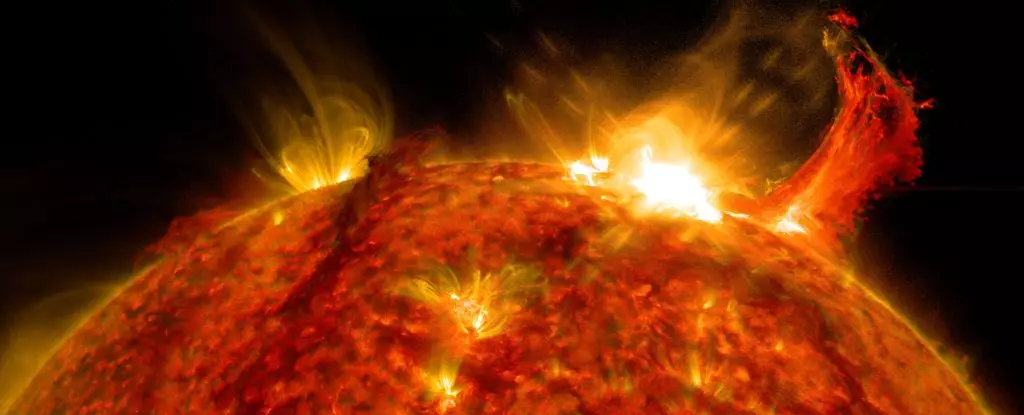Around 14,300 years ago, our planet bore witness to a colossal cosmic event that profoundly impacted its atmosphere and inhabitants. A burgeoning body of research indicates that a massive solar outburst occurred circa 12350 BCE, leaving traces detectable in ancient tree rings and ice cores. The findings have evolved significantly, especially with the introduction of the SOCOL:14C-Ex climate-chemistry model—a cutting-edge analytical tool revolutionizing how we understand these ancient phenomena. What did this ancient solar storm entail, and how does it inform our understanding of the Sun’s behavior over millennia?
The Science Behind Solar Outbursts: Understanding Geomagnetic Storms
To appreciate the impact of the 12350 BCE event, we must first comprehend what a geomagnetic storm is. Typically triggered by coronal mass ejections—massive expulsions of solar plasma—these storms unleash billions of tons of charged particles onto Earth. The famous auroras—canvas-like displays of brilliant colors in the polar skies—are just the surface manifestation of these ferocious storms. The intertwining of these solar outbursts and human-made technologies results in significant disruptions, as evidenced by the Carrington Event in 1859, which devastated telegraph systems globally.
In stark contrast to contemporary disturbances, the 12350 BCE solar storm is estimated to be over 500 times more intense than modern events, as reported by researchers like Kseniia Golubenko from the University of Oulu. This extraordinary force raises concerns about our vulnerability in the face of solar fury and challenges existing paradigms surrounding cosmic activity.
Reconstructing the Solar Timeline: Carbon-14 as a Key to Understanding
Researchers have leveraged carbon-14 in an innovative way to refine our understanding of these historical events. Carbon-14 is formed when cosmic particles collide with atmospheric constituents, leading to its incorporation into living organisms. This isotopic marker decays at a predictable rate, allowing scientists to date ancient trees, contributing to a timeline of solar activity. The remarkable spike in carbon-14 levels during the 12350 BCE event illustrates the destructive potential of solar storms and anchors it in Earth’s geological history.
The new methodology employed by scientists marks a departure from previous research centered exclusively on the Holocene epoch. This gain in understanding for glacial conditions paves the way for broader reconstructions of Earth’s atmospheric experiences, especially concerning extreme solar events. It is an impressive leap forward, challenging ideas about solar storms’ periodicity and intensity throughout time.
A Shift in Perspective: The Implications of Ancient Cosmic Fury
The magnitude of the solar storm from 12350 BCE begs a reevaluation of our assumptions about historical solar activity and climate. The significant intensity of this storm presents it as a “worst-case scenario,” as described by researchers attempting to understand its ramifications. This perspective not only illuminates Earth’s climatic history but also underscores the urgency for modern society to rigorously prepare for solar activity’s potential impacts.
As the frequency and intensity of solar storms appear to oscillate, bolstered by the ever-evolving understanding of our solar system, there’s inherent value in examining such ancient events. They provide critical insight into what we may expect in our future—an understanding that could mean the difference between technological advancement and catastrophe.
The Future of Solar Research: What Lies Ahead?
As scientific exploration deepens, the spotlight on solar phenomena intensifies. This emerging field stands at the forefront of interdisciplinary research, bringing together solar physicists, climate scientists, and geologists to navigate the unknowns of our solar neighbor. As models like SOCOL:14C-Ex unveil fresh insights into historical events, they simultaneously forecast potential scenarios through which modern civilizations must navigate the intricacies of solar behavior.
The impact of the 12350 BCE event is not just historical; it resonates soundly with contemporary society as we increasingly rely on technology vulnerable to solar outbursts. The integration of historical data, advanced modeling, and predictive analytics is crucial for constructing resilient systems that can weather the formidable effects of cosmic forces. The narrative of our planet is laced with cosmic threads; understanding these ancient solar events may provide the knowledge required to safeguard our future amidst the storm.


Leave a Reply